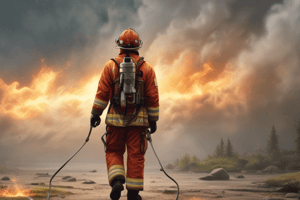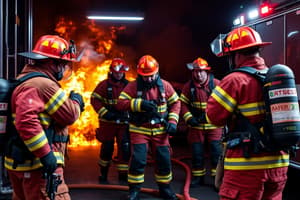Podcast
Questions and Answers
During the growth phase of a fire in a closed compartment, what effect does the location of the fuel source have on gas temperatures?
During the growth phase of a fire in a closed compartment, what effect does the location of the fuel source have on gas temperatures?
- Fuel sources near the center lead to higher gas temperatures due to less air intake.
- Fuel sources in corners result in the lowest temperatures because of maximum air mixing.
- Fuel sources near the walls lead to lower gas temperatures due to increased air intake.
- Fuel sources near the walls result in higher gas temperatures due to limited air intake. (correct)
What distinguishes a flashover from a backdraft in terms of the ignition process?
What distinguishes a flashover from a backdraft in terms of the ignition process?
- A flashover occurs in oxygen-rich environments, while a backdraft occurs in oxygen-depleted environments. (correct)
- A flashover is a rapid decrease in temperature, and a backdraft is a rapid increase in temperature.
- A flashover involves pre-mixing of gases with air, whereas a backdraft involves immediate ignition of all gases.
- A flashover involves immediate ignition of all gases, whereas a backdraft requires pre-mixing of gases with air.
What role do low ceilings play in the speed of fire propagation within a structure?
What role do low ceilings play in the speed of fire propagation within a structure?
- Low ceilings only affect the amount of smoke produced, not the speed of fire spread.
- Low ceilings have no significant impact on the speed of fire propagation. (correct)
- Low ceilings slow down fire propagation because heat is trapped near the floor.
- Low ceilings promote rapid fire spread by enabling flames to quickly reach the ceiling and radiate heat to other combustibles.
During which stage of fire development in a closed compartment are all combustible materials fully burning?
During which stage of fire development in a closed compartment are all combustible materials fully burning?
What is a key indicator of a potential backdraft situation?
What is a key indicator of a potential backdraft situation?
Before breaching a door during a structural fire, what action should firefighters take to assess conditions and mitigate risks?
Before breaching a door during a structural fire, what action should firefighters take to assess conditions and mitigate risks?
What thermal property of compartment enclosures significantly influences fire development?
What thermal property of compartment enclosures significantly influences fire development?
Why is it important to control ventilation during the decay phase of a fire?
Why is it important to control ventilation during the decay phase of a fire?
At what approximate radiant heat flux does flashover typically occur?
At what approximate radiant heat flux does flashover typically occur?
What is the primary influence on temperature during the growth phase of a fire inside a compartment?
What is the primary influence on temperature during the growth phase of a fire inside a compartment?
Flashcards
What is ignition in the context of fire development?
What is ignition in the context of fire development?
The period where all elements capable of starting a fire begin to interact, either provoked by a spark or flame, or unprovoked, when a material reaches its ignition temperature spontaneously.
What happens during the growth stage of a fire?
What happens during the growth stage of a fire?
After ignition, a cushion of fire gases forms above the burning fuel. Air is drawn in, influencing the fire's temperature. The closer the fuel source to walls, the higher the gas temperatures.
What is a flashover?
What is a flashover?
The rapid transition from a growth stage to a fully developed fire, where conditions in the compartment change quickly, and the fire spreads to all combustible materials.
Describe a fully developed fire.
Describe a fully developed fire.
Signup and view all the flashcards
What happens during the decay or decrecimiento phase?
What happens during the decay or decrecimiento phase?
Signup and view all the flashcards
What is backdraft?
What is backdraft?
Signup and view all the flashcards
Name three indicators of a potential backdraft.
Name three indicators of a potential backdraft.
Signup and view all the flashcards
What are indicators of a flashover?
What are indicators of a flashover?
Signup and view all the flashcards
What are the four factors influencing fire development
What are the four factors influencing fire development
Signup and view all the flashcards
Safety actions involving fire
Safety actions involving fire
Signup and view all the flashcards
Study Notes
- These notes cover the control and extinguishing of interior fires, focusing on key concepts, fire classes, extinguishing agents, fire development in closed compartments, and water as an extinguishing agent.
Fire Basics
- Fire involves exothermic reactions like oxidation.
- Understanding ignition and autoignition temperatures is crucial.
- Flammability limits define the range in which a substance can ignite.
- Heat spreads through conduction, convection, and radiation.
- Flames include diffusion and premixed types.
- Dangerous gases are produced during fires.
- The fire triangle/tetrahedron illustrates extinction methods like elimination, suffocation, cooling, and inhibition.
Fire Classes and Extinguishing Agents
- Fires are classified into A, B, C, and D, each requiring specific extinguishing agents.
- Water acts by cooling and is applied in various ways.
- Foam extinguishes by smothering.
- Powder extinguishers inhibit chemical reactions.
- Carbon dioxide (CO2) smothers fires.
- Halons, though effective, have limited use due to environmental concerns.
- Inert gases are also used for extinguishing.
- Agent selection depends on the fire class.
Fire Development in Confined Spaces
- Fire development in closed compartments follows phases: ignition, growth, flashover, fully developed fire, and decay.
- Flashover is a rapid transition to a fully developed fire, with temperatures between 483°C and 649°C.
- Backdrafts are explosions caused by introducing fresh air into a smoldering, oxygen-deficient compartment.
Factors Influencing Fire Development
- Ventilation openings, compartment volume, thermal properties of enclosures, and ceiling height influence fire behavior.
- Fuel characteristics like size, composition, location, and availability of additional sources are crucial.
- The extent of the fire is influenced by how quickly flames reach the ceiling.
Backdraft Characteristics
- Backdrafts exhibit "breathing" or pulsating airflow.
- Deflagration is a rapid but progressive combustion of gases within flammability range.
Indicators and Safety for Flashover and Backdraft
- Backdraft indicators include dense smoke, pulsating smoke, and heat around doors.
- Flashover indicators include a rapid temperature increase and rollover.
- Safety measures involve appropriate PPE, escape route verification, and specific ventilation techniques.
Water as an Extinguishing Agent
- Effective use involves solid streams or spray.
- Extinction methods include confining, controlling, and extinguishing using direct, indirect, open, closed, gas control, or offensive strategies.
- Ventilation is key, involving specific procedures for smoke, heat, and gas removal.
- Natural and forced ventilation techniques exist.
- Positive and negative pressure ventilation are also used.
High-Rise Building Fires
- Intervention strategies include information gathering and establishing operational sectors (command, extinguishing, rescue, reserve personnel, and vehicle staging).
- Attack alternatives include no attack, frontal, lateral, defensive, and exterior approaches.
- Ventilation options are horizontal or vertical.
Fires in Underground Parking Garages
- Parking garages vary in layout, impacting fire response.
- Combustible materials present in parking garages are a factor in fire development.
- Fire suppression focuses on access, smoke control, and automatic suppression systems.
Studying That Suits You
Use AI to generate personalized quizzes and flashcards to suit your learning preferences.
Related Documents
Description
Comprehensive notes on controlling and extinguishing interior fires, covering fire classes (A, B, C, D), extinguishing agents such as water, foam, powder, and CO2. The notes include fire development in closed compartments. Key concepts like ignition temperature, flammability limits, and heat transfer methods are discussed.




